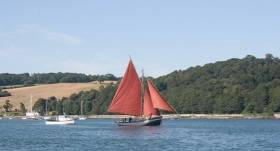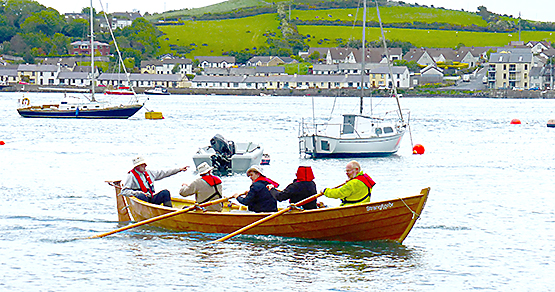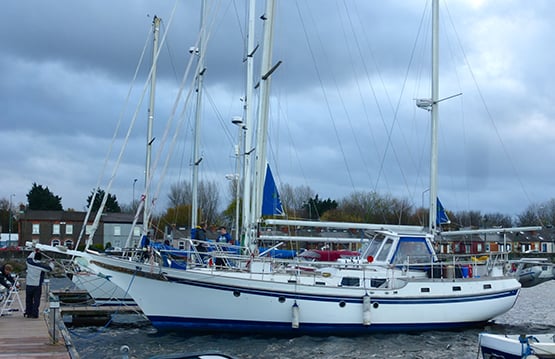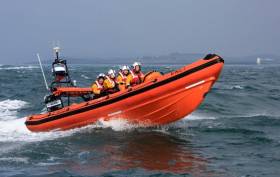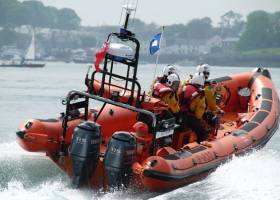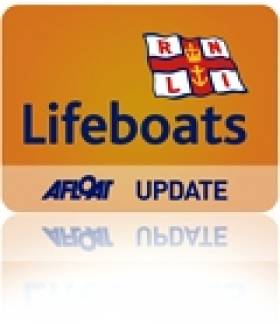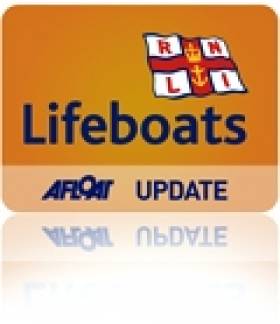Displaying items by tag: Portaferry
Portaferry Sails & Sounds Will Broaden Life In The Narrows
The revival of Portaferry in Strangford Narrows as a mid-summer focal point for classic and traditional sail afloat, combined with traditional music and festivities ashore, is set to take place from Thursday June 16th to Sunday June 19th this year with the newly branded and re-vamped Portaferry Sails & Sounds Festival 2016 writes W M Nixon
Time was when the highlight for traditional sailors at Portaferry, where the tides sluice with some strength in and out of Northern Ireland’s saltwater lake of Strangford Lough, was racing by restored Galway hookers - they came north in substantial numbers in late June from their home ports in the greater Dublin area. But it is the new Dublin-Galway motorway – of all things - which has seen numbers of traditional craft around Dublin Bay decline as they migrated back to their newly-accessible true heartlands around Galway Bay, such that now if you want to be sure to see hookers - including many Dublin-owned ones - racing in strength, you need to go Macdara’s Island off Connemara for St MacDara’s Day – July 16th – or to Kinvara at the head of Galway Bay for Cruinniu na mBad, which in 2016 is August 19th to 21st.
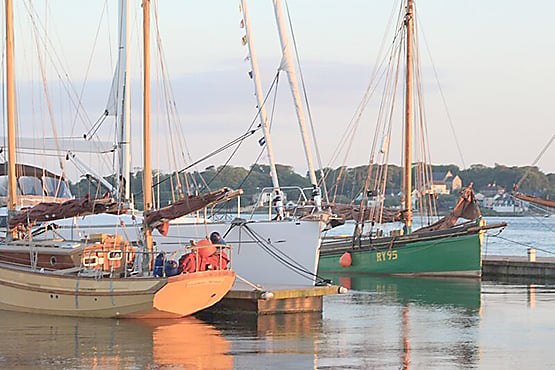
Alan and Irene Aston’s Cornish Crabber Golden Nomad in Portaferry Marina, while beyond with bowsprit housed is Joe Pennington’s famous Manx Longliner Master Frank
But there are other places in the Irish Sea where traditional craft and interesting old gaffers are to be found, notably in North Wales and particularly in the Isle of Man, where Joe Pennington has restored the last Ramsey Longliner – Master Frank – into superb sailing conditions, while Mike Clark continues to maintain the Manx nobby White Heather under her classic labour-intensive lugger rig.
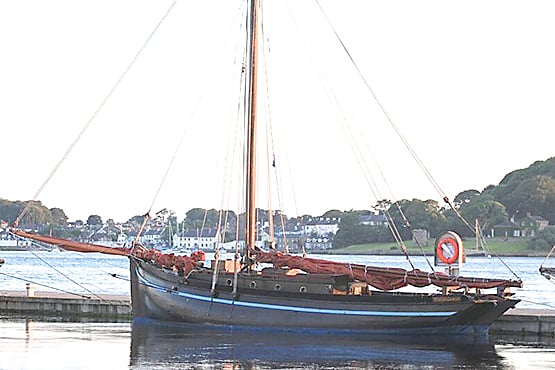
Naomh Cronan in Portaferry Marina
As well of course, the big Clondalkin-originated Galway Hooker Naomh Cronan continues to make the Irish Sea her home base, sailing from Poolbeg in Dublin, and there’s an increasing number of classic restored gaff yachts at many centres all round the Irish Sea and the Firth of Clyde, which link together through the Old Gaffers Association. This will provide a real increase in the fleet which this year will make Portaferry a major happening again, the interest further heightened by the presence of Strangford Lough’s fleet of nine-plus Iain Oughtred-designed four-oared skiffs, which have a regular racing programme in the lough.
The Strangford Village Rowing Club’s skiff in action at their home port, with Portaferry just across the narrows. Photo: W M Nixon
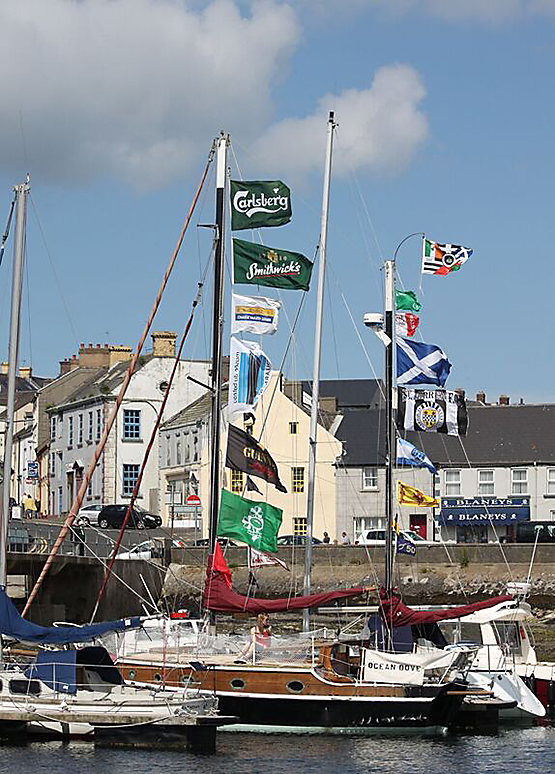
Gary Lyons’ ketch Ocean Dove in party mode in Portaferry Marina
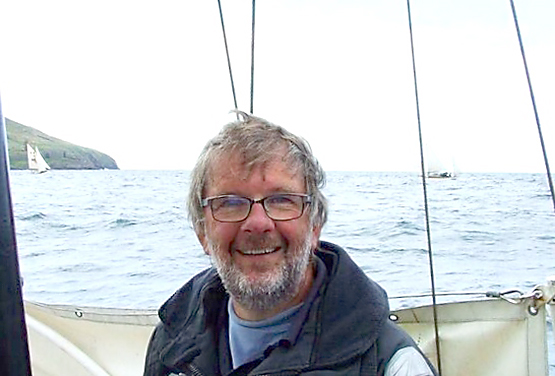
Adrian “Stu” Spence, one of the main movers and shakers behind the new-look Portaferry Sail & Sounds 2016 in June.
The two powers in the land who are making sure it all takes off are Garry Lyons of the Northern Ireland Old Gaffers Association, skipper of the vintage ketch Ocean Dove, and another northern sailor, the legendary Adrian “Stu” Spence, who in 2014 finally parted from his incredibly old Pilot Cutter Madcap (she may have dated back as far as 1873), which over many seasons he’d cruised to places as distant and different as Greenland and Spain.
In the Autumn of last year he came into Poolbeg with his new Mediterranean-acquired vessel, a rakishly clipper-bowed Vagabond 47 ketch which Skipper Spence currently refers to as “The Love Boat” – we look forward to learning of the official name in due course. The new ship was in Poolbeg in order to access the specialist talents whom Stu Spence has got to know during his long years with the Old Gaffers, in order to make the big ketch fit for anything before she finally goes on to her home mooring at Ringhaddy in Strangford Lough, and she’ll admirably fulfill the role of one of the flagships for Portaferry Sails and Sounds in June.
Stu Spence currently refers to his newly-acquired Vagabond 47 ketch – seen here in Poolbeg Marina – as “The Love Boat”. Photo: W M Nixon
Run jointly by the Northern Ireland Old Gaffers Association and Portaferry Sailing Club, Portaferry Sails & Sounds 2016 promises the perfect mixture of sport and spectacle, sailing and singing, and dancing and divilment to make the Midsummer Weekend pass merrily in the classic and traditional style.

Mike Clark’s traditionally-rigged Manxy Nobby White Heather from Peel is expected in Portaferry in June
#RNLI - The volunteer lifeboat crew at Portaferry RNLI launched yesterday afternoon (Tuesday 8 March) to the aid of two kayakers stranded on an island in Strangford Lough.
The two men were on a camping trip to Boretree Island, just off the coast at Mount Stewart, and had paddled out to set up their tent.
When they returned to where they had landed their kayak, they found that it had drifted off in the tide.
Waving a flag to attract attention, the two men were spotted by walkers on the mainland shore who contacted the coastguard, who subsequently requested Portaferry RNLI to launch to rescue the campers.
Weather conditions at the time were good, slightly cloudy with a slight Force 3 wind. Visibility was good and sea conditions were also fairly calm.
The volunteer crew of the Portaferry lifeboat, an inshore Atlantic 85, launched at 12.40pm and were quickly on scene, where they transferred the two men into the lifeboat. They were then taken safely to shore at Newtownards Sailing Club.
Brian Bailie, lifeboat operations manager for Portaferry RNLI, said: "We are delighted to once again have been able to provide assistance to members of the public who found themselves in trouble at sea.
"With its fast flowing currents and tides, Strangford Lough can at times catch out even the most experienced. The lough has for a long time and will for the foreseeable future be a real draw for water enthusiasts and we at Portaferry RNLI are always ready to provide assistance when required."
Portaferry Lifeboats Rescues Two Anglers With Engine Trouble
#RNLI - The volunteer lifeboat crew at Portaferry RNLI launched yesterday evening (Thursday 18 February) to go to the aid of two men on board an angling boat experiencing engine problems off the Co Down coast.
The volunteer crew of Portaferry's Atlantic 85 inshore lifeboat launched at 6.45pm having received a launch request from Belfast Coastguard concerning two on board a 36ft angling boat in South Bay, north east of Ballyquinten Point.
The two on board the stricken vessel had been en route to Carrick Marina when they started to lose power and contacted the emergency services for assistance.
Weather conditions at the time were described as clear with a slight sea swell with excellent visibility and a Force 1-2 westerly wind.
The lifeboat crew arrived on scene at 7.10pm. Having assessed the situation and with nobody in immediate danger, the RNLI crew established a towline and brought the casualty vessel in to Portaferry Marina in Strangford Lough, Co Down.
Speaking following the callout, Portaferry RNLI lifeboat operations manager Brian Bailie said: "Once again it has been a great outcome and testament to the hard work and training the RNLI volunteers put in to answer calls for help at sea.
"The two men on board the casualty boat took the right decision to call for assistance before their situation could become potentially more serious."
Portaferry's Inshore Lifeboat Rescues Kayakers In Challenging Conditions On Strangford Lough
#RNLI - The Volunteer lifeboat crew at Portaferry RNLI launched yesterday (Thursday 12 November) to the aid of three men in kayaks on Strangford Lough.
Portaferry's Atlantic 85 inshore lifeboat launched at 12.38pm having received a launch request from the coastguard concerning the three men who found themselves in some difficulty during their kayaking trip on the lough.
One of the men had lost his paddle, subsequently ending up in the water.
At the time there was a Force 7 south south-west wind close to a gale with rough sea conditions and fair visibility.
The volunteer crew were on scene northeast of Limestone Rock at 12.46pm where the three kayakers had formed a 'raft' with their vessels while waiting for the RNLI Lifeboat to arrive.
Coming alongside the trio, the lifeboat crew proceed to load them and their kayaks into the lifeboat before returning to the pontoons at Strangford in Co Down were all were put safely ashore.
Brian Bailie, lifeboat operations manager for Portaferry RNLI, said: "The hard work and dedication of our volunteers has once again resulted in the safe return to shore of three men who had got into some difficulty at sea.
"In what were very tricky weather conditions, the three men had acted promptly and correctly when they realised that they were in trouble.
"Once again we are all delighted with the outcome and urge anyone considering going on the water at this time of year to take all necessary precautions."
Search for Missing Aircraft Near Isle of Man
An extensive search is being carried out of an area south west of the Isle of Man after an emergency code was received from an unknown aircraft.
UK Coastguard is overseeing the search after the Aeronautical Rescue Coordination Centre at RAF Kinloss called to say that the aircraft had been lost on the radar.
A search between Northern Ireland and the south west of the Isle of Man is being carried out.
Two RNLI boats, one from Newcastle (Northern Ireland) and Port St Mary (Isle of Man), the Irish Coastguard search and rescue helicopter based at Dublin and two Coastguard Rescue Teams, one from Portaferry (UK Coastguard) and Castletown (IOM Coastguard) are all involved.
Ryan Gray, senior maritime operations officer at the UK Coastguard said: ‘We also issued a Mayday relay in the area which means that other merchant shipping are also keeping a lookout for this aircraft.’
‘This is the first time we’ve worked with the Isle of Man Coastguard since joining the national network.'
The search remains ongoing.
#RNLI - The volunteer lifeboat crew at Portaferry RNLI were called out yesterday evening (Thursday 9 July) in response to a call to the emergency services.
A member of the public had reported that a small sailing boat, a Topper with two people on board, appeared to be in difficulty in the vicinity of Don O’Neill Island near Killyleagh, Co Down.
The volunteer crew of the Portaferry lifeboat were paged just before 7.00pm and the RNLI lifeboat, an inshore Atlantic 85, was launched at 7.07pm. At the time the weather was fine with good visibility, a gentle swell and slight breeze.
The RNLI crew arrived on scene at 7.12pm where the two sailors, an adult woman and a teenage boy, had taken the small sailing boat out of the water on to the island where they were waiting for the tide to turn. Both were unharmed and properly equipped wearing lifejackets and wetsuits.
As the wind was starting to pick up strength, the two sailors agreed to return to Portaferry Marina with the volunteer RNLI crew and were subsequently taken onboard the lifeboat with their small boat before being safely put ashore at the marina at 7.38pm.
Portaferry Lifeboat Rescues Man Caught Out By Tide
#RNLI - Portaferry RNLI has rescued a man who got caught out by the tide yesterday afternoon (Monday 22 December).
The volunteer lifeboat crew was requested to launch their inshore lifeboat at 2.24pm following a report of person in the water on Strangford Lough.
A kayaker who was in upper parts of the lough at the time raised the alarm after he saw a man waist-deep in the water.
The lifeboat launched and headed towards Rainey Island at the north end of Strangford Lough, arriving on scene at 2.50pm, and the crew began a search of the area around Rainey and Sketrick Islands.
When nothing was found, the lifeboat carried on up into Watson Island on Ardmillan Bay, where the crew located the casualty.
The man, who was a wildfowler, had set off walking to the island earlier in the morning when the tide had been out but then got caught out by the rising tide.
It was when he was attempting to return to the mainland that he was spotted by the kayaker waist deep in the water.
With the water getting deeper the man decided to return to the island for his own safety, where he was waiting when the lifeboat located him.
In what is a muddy area that can be dangerous, the Portaferry crew carefully manoeuvred in shallow water to get to the man and bring him on board the lifeboat.
The casualty, who was cold and fatigued but who didn’t require any further medical attention, was then transported to Ballydorn.
Speaking following the callout, Portaferry RNLI lifeboat operations manager Brian Baille commended the kayaker who had raised the alarm.
"The kayaker spotted the casualty, raised the alarm and then stayed with the man until the lifeboat arrived on scene and brought him to safety. Had the alarm been raised later it would have been much trickier to locate the casualty in the dark.
"We would remind anyone planning to go out on the lough to be mindful of the weather and tide times."
Dickie Brown 1933-2014
Dickie Brown of Portaferry, builder of the Ruffian range of yachts and one of Ireland's most accomplished sailors, has died at the age of 81 after a long and well-lived life. His three abiding passions were his family, his boats and their interaction with the sea, and devoting his working career towards increasing the prosperity and quality of life in his home town of Portaferry.
Portaferry is at the far southern end of the long Ards Peninsula in County Down, set on the east side of the tide-riven Narrows which flow from the Irish Sea into Strangford Lough. The ferry service across the Narrows to Strangford village to maintain the connection with central County Down has not always been the efficient link it is today, and for much of their boyhood the three Brown brothers - Tom, Billy and Dickie – lived in an isolated town which for many was economically deprived.
However, the brothers were able to break away from the limitations of small town life. Tommy followed a career in law which resulted in his becoming Sir Thomas Brown, while Billy – after service in World War II flying from aircraft carriers with the Royal Navy - became a university lecturer in physics, electronics and engineering. But Dickie – after various youthful adventures – was determined to be Portaferry-based, and his brothers were to back him in his boat-building project with Weatherly Yachts, for which Billy was the successful designer.
It was only after considerable experience in sailing and other areas of business that they felt sufficiently confident to set up the firm. In his younger days, Billy had become the owner of the Marie Michon, a notably hefty 28ft gaff cutter based on the Falmouth Working boat type. It was on this boat that Dickie had his first seagoing experience, so it was intriguing that when he decided to get a boat of his own inclinations in partnership with Billy in 1962, he went in completely the opposite direction, and settled on Black Soo, a 1957-built ultra-light Van de Stadt-designed 30ft offshore racing cutter of very minimal accommodation.

She was just a slip of a boat. Dickie Brown working on the topsides of Black Soo at Portaferry pier in 1964. Photo: W M Nixon
He bought the boat through her builders, Bob and Wally Clark of Cowes, thereby forming another of many lifelong friendships through which he learned much about the ways and means of running a boat-building operation and surviving in the marine industry. When Black Soo appeared for the first time in the decidedly conservative setting of Northern Ireland sailing 52 years ago, she looked sensationally different to anything else on the growing local offshore racing scene. But she successfully came through the gale-tossed first RUYC Ailsa Craig Race of 1962, and in 1963 she won it overall, going on through the mid 1960s to cut a swathe through fleets on both sides of the North Channel and in the Irish Sea, with a sensationally-fast performance in any heavy weather offwind sailing.
By 1967 Dickie had done his first Fastnet Race as a crewman, and after his second in 1969 he decided to build himself a 35-footer to his own ideas with the design created by brother Billy, who by this time had moved back to live in Portaferry and raise a family. Billy was to find that he did his best yacht design work after about three o'clock in the morning, "when the air isn't cluttered by other people thoughts".
Dickie meanwhile had married Joyce, a talented New Zealand artist, and they'd built themselves a house on the side of Bankmore Hill, right above the narrowest part of the Narrows and looking north into Strangford Lough. At the bottom of the field which now became the garden, a shed went up. It was originally planned as a pig house, as agricultural production was one of Dickie's many business interests. But soon the pigs were out, and the hull of a 35-footer started to appear instead, built upside down in three glued skins of diagonal planking and superbly constructed, for Dickie was a natural craftsman in wood.
Thus was Ruffian created, and it was a wonderful day in the early summer of 1971 when she was launched for the first time in a carnival family and community effort, the day going so smoothly, with successful afternoon sailing trials, that Joyce was moved to create a watercolour of it all, and that picture can still be seen in Portaferry today.
Ruffian made an impressive debut during 1971, but it was 1972 which saw her at her best on the offshore scene at home and abroad, winning practically everything she took part in. Yet she was already for sale, as the genesis of Weatherly Yachts was well under way, and in March 1973 the prototype of the GRP Ruffian 23, designed in Portaferry, built in Portaferry, and first sailed in Portaferry, made her successful debut.
The Ruffian 23 was the right boat at the right time. Local offshore racing was developing at many centres, and the able and attractive little performance sailer found ready buyers at home and abroad. At the height of its success, the Ruffian 23 was to be found in varying and often substantial numbers in places as widespread as Belfast Lough, Strangford Lough, Dublin Bay, the Isle of Man, Scotland, northwest England, Iceland and Hong Kong.

The prototype Ruffian 23 on her maiden sail, March 1973. Photo: W M Nixon
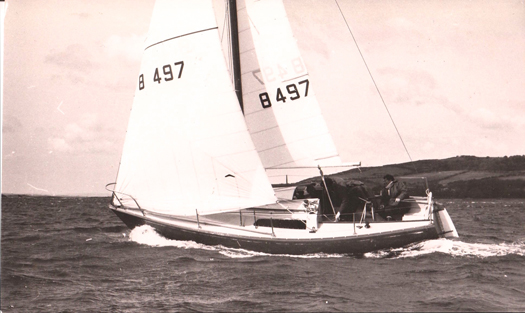
The right boat in the right place at the right time in 1973. The gallant little Ruffian 23 attracted adherents worldwide, and continues to race as a class in Dublin Bay and at Carrickfergus. Photo: W M Nixon
Today the class is still to be actively found in Dublin Bay and at Carrickfergus. But racing inshore and offshore wasn't the only area of success, Ruffian 23s were also cruised extensively with round Ireland ventures, and voyages to distant exposed islands such as St Kilda, satisfyingly completed. The Ruffian 23 sailors formed a maritime brotherhood (and sisterhood) which many maintain to this day, even when they have moved on to larger craft.
Weatherly Yachts also moved on to larger models, while maintaining a steady production of Ruffian 23s to provide good work in that former unemployment blackspot. New ventures included the 30ft Half Tonner Rock'n Goose (it's the local pronunciation for Rock Angus, the lighthouse-topped reef in the Narrows) which took part in the Half Ton Worlds at La Rochelle in France in 1974, and came through unscathed from a 180 degree roll in a huge Biscay storm, her survival in good order a credit to Dickie's boat-building skills. But for the next boat up in their range, Weatherly eventually settled on the 28ft Ruffian 8.5, which achieved success in a variety of ways, not least in the late Mike Balmforth's Sgeir Ban, which was fractionally-rigged to give a potent performance, and also proved herself as a very able cruiser on the Scottish and Irish coasts.
When the going was good for Weatherly Yachts of Portaferry, it was very good. But the increasing dominance of large often government-backed Continental companies in the mass-production boat-building industry meant that the longterm prospects for a small family firm in a remote location were increasingly negative. In fact, looking back, we can now realize that the Brown brothers with Weatherly Yachts hit the ground running with good ideas and a keen workforce just at the one juncture when a business with this scale and location could succeed, and they made the very best of the opportunity to provide a golden era for Portaferry.
With the firm quietly closing down after a gallant effort, Dickie was able to return to other business interests and his first love afloat – classic wooden yachts. His boat for the final long phase of his life was very different from the boisterous little plastic Ruffians, as it was the exquisite teak-built Arthur Robb-designed 42-footer Jaynor, which Dickie as a young man had watched being meticulously built by Bruce Cowley in Bangor Shipyard on the shores of Ballyholme Bay in the early 1960s.
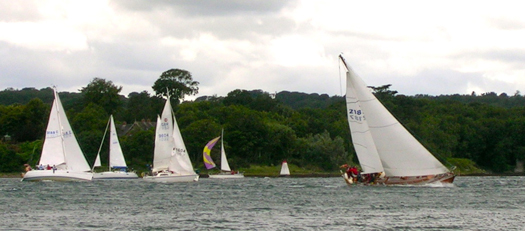
The classic yacht for a senior sailor. Jaynor with Dickie Brown at the helm storms into the lead at a breezy Portaferry Regatta. Photo: James Nixon
Dickie Brown and his family and friends with Jaynor became a familiar sight at classic events at home and abroad, but always his first love was to be sailing from Portaferry on the waters with which he'd been engaged all his life. Eventually, ill health meant Jaynor had to be sold, but even despite his infirmities, Dickie was still able – in his 80th year – to take part and finish in the Golden Jubilee Ailsa Craig Race in 2012, one of the very few who had done the same in the first race of 1962.
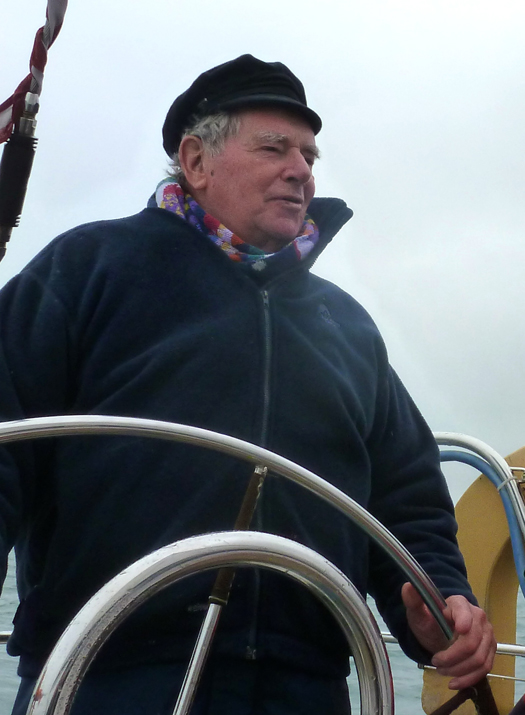
The lifelong enthusiast. Dickie Brown at the helm at the finish of the Golden Jubilee RUYC Ailsa Craig Race in 2012. He regularly sailed in the race from its inception in 1962, and was overall winner with Black Soo in 1963. Photo: W M Nixon
Now into his eighties, and with grandchildren to cherish, his interest in boats and his home waters never diminished, and he had many friends to help him get afloat. My own last sight of him out in a boat was just last year. We were coming in to Strangford Narrows with the new flood, and there was a useful little fishing launch bobbing about on the bar, having come down with the last of the ebb to take advantage of any good fish coming in on the new tide.
As we shaped on our course into the Narrows, the little boat completed her brief but successful task and started to head home to Portaferry, motoring alongside us for a while to say hello. It was Dickie and some friends, in good form and out for a spot of neatly-timed fishing before Sunday lunch.
It was a moment to treasure, a good way to remember a great man of the sea and the coast, a man who enriched the lives of all who knew him. Our thoughts are with Joyce, and Richie, Fraser (a former Olympic sailor for Ireland in 2004) and Karen and the grandchildren at this sad time.
WMN
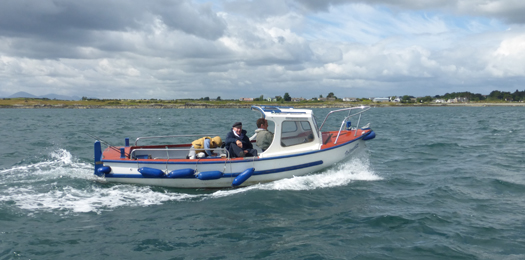
A last sight of Dickie Brown afloat on his home waters. It's August 2013, and with some friends he has come down through Strangford Narrows with the last of the ebb for some useful fishing on the bar, and is now returning to Portaferry with the new flood, nicely on time for Sunday lunch. Photo: W M Nixon
Portaferry Lifeboat Assists Family On Stranded Yacht
#RNLI - Portaferry RNLI received a request to launch their inshore lifeboat at 10.40am this morning (22 July) to the aid of a family on board a stranded yacht.
The lifeboat launched at 10.47am and arrived at the scene just south of Dogtail Point in Strangford Lough, Co Down seven minutes later.
The 13m yacht had run onto rocks where it remained stranded with the two adults and two children onboard until the help arrived.
Weather conditions at the time were very foggy with poor visibility, a Force 2 southerly breeze and calm seas.
When the volunteer crew from Portaferry RNLI arrived, they were assisted by the crew of a local boat, the Cuan Rib, in easing the stranded yacht on board clear of the rocks.
The volunteer lifeboat crew then inspected the yacht for damage at the scene before escorting the vessel and its passengers safely back to Portaferry Marina.
#RNLI - Portaferry RNLI launched its inshore lifeboat yesterday afternoon (14 July) to the aid of a man who had suffered a head injury in one of the races during Portaferry Sailing Club’s annual regatta.
The lifeboat launched at 2.36pm and met up with the injured man a few minutes later on board his 12m yacht just off Marfield Bay in Strangford Lough, Co Down.
Weather conditions at the time were cloudy with good visibility, with a Force 2 to 3 southerly wind and calm seas.
After assessing the injured man’s condition, the volunteer crew transferred him into the lifeboat before taking him to Strangford Harbour, where he was then passed into the care of the Northern Ireland Ambulance Service.
Around the same time, RNLI Bangor was launching to investigate reports that children could have been on board an abandoned homemade raft spotted adrift off Ballymacormick Point on the edge of Belfast Lough.
Calm seas and fine weather allowed the lifeboat to proceed at full speed to the search area between Ballymacormick Point and Orlock Point.
After an extensive two-hour search of the area in conjunction with a fishing vessel and a coastguard rescue team, nothing was found.
The search was later terminated when enquiries found that there was a high probability that the raft had drifted from shore during high water.
Michael McKenna, volunteer RNLI helmsman who was involved in the search, took the opportunity to remind all children playing along the coast of the SAFE code: S for spot the dangers, A for always go with a friend, F for find and follow the safety signs and flags and E for Emergency - put up your hand and shout or ring 999/112 and ask for the coastguard.
It was the third callout for Bangor RNLI in three days, after a busy Saturday 12 July that began with a morning request from Belfast Coastguard to assist in the search for an inflatable dinghy.
The dinghy had been spotted by a concerned member of the public at the mouth of Larne Lough. The Bangor volunteer crew joined the Larne RNLI lifeboat in the search for the dinghy and its occupants. The former were quickly on scene and found the dinghy deserted with its engine down and a rope around the propeller.
The name painted on the dinghy hull was passed to Belfast Coastguard who were able to contact the owners. Thankfully, the owners reported that the dinghy had broken free from their vessel and that no one was on board.
The second call of the day came at 11:55am when the Bangor lifeboat launched to rescue four people from a motor boat that had broken down off the oil jetty at Cloghan Point, on the northern shores of Belfast Lough.
On scene, the RNLI crew quickly evaluated the situation and manoeuvred the lifeboat close to the broken-down vessel.
With relatively calm weather conditions, a tow rope was rigged and successfully passed to the motor boat, which was then towed the four miles back to the safety of Bangor Marina.
"Engine failure close to shore could lead to a life-threatening situation," said Bangor RNLI volunteer helmsman Iain Dobie.
"We always urge everyone going to sea to make sure their electrical systems and engine are well maintained and in good working order. A good anchor and chain should always be carried as part of essential safety equipment.
"We are glad the family on board this vessel are now safely ashore," he added.


























